ASUS UL80Vt and G51J: Going for the Gold
by Jarred Walton on December 15, 2009 1:30 AM EST- Posted in
- Laptops
ASUS UL80Vt Application Performance
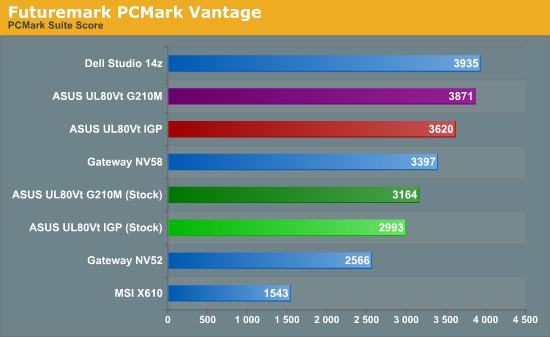
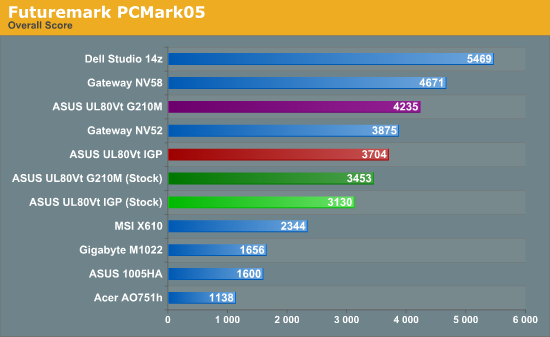
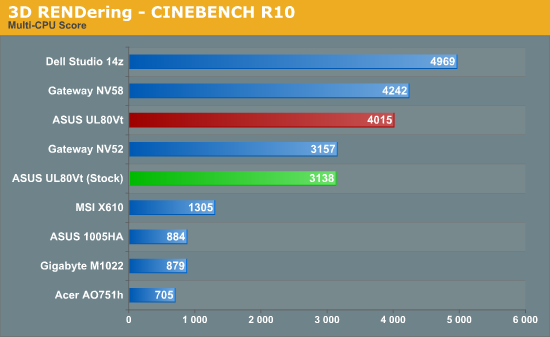
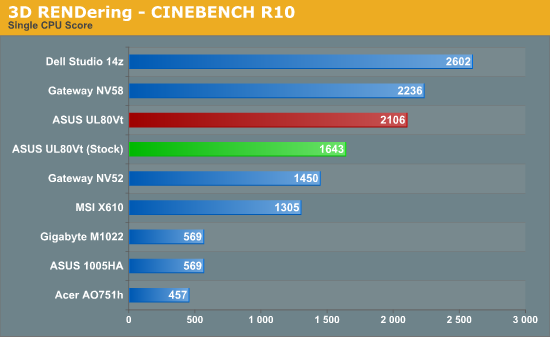

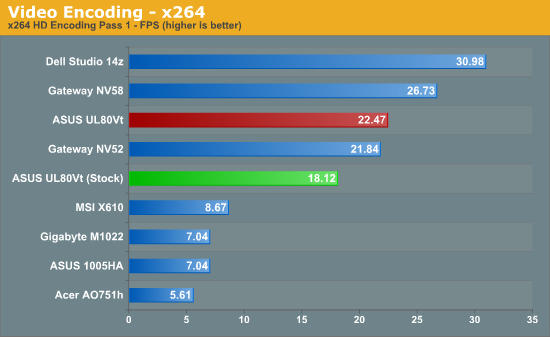
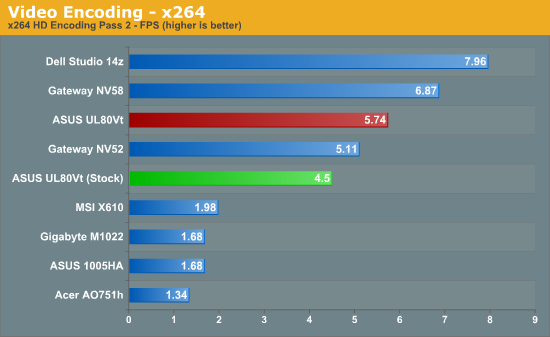
With Turbo33 and the G210M enabled, the UL80Vt is neck-and-neck with the Dell Studio 14z in PCMark Vantage, the most comprehensive picture of general application performance. PCMark05 places more of an emphasis on CPU clocks, so the 14z with P8600 ends up around 30% faster. That ~30% advantage holds when we move to CPU intensive applications like video encoding and 3D rendering where the 14z is 38% and 23% faster, respectively.
If you prefer battery life and want to disable the G210M and run the CPU at stock speed, the gap between the UL80Vt and the 14z grows substantially. PCMark Vantage shows a 31% advantage, PCMark05 75%, CINEBENCH 58%, and video encoding around 75% - not that you're likely to try doing video encoding or 3D rendering while unplugged on this sort of laptop.
If you want a different comparison that shows exactly why we're so keen on CULV laptops, take a look at the stock IGP configuration of the UL80Vt and compare that with any of the netbooks. In that case, the UL80Vt is over twice as fast in PCMark05 and 2.5 to 3.5 times faster in CPU intensive tasks like video encoding and 3D rendering. Sure, the UL80Vt costs over twice as much as a typical Atom-based netbook, but there are plenty of other CULV laptops with prices starting at $400 for the Acer 1410. The PCMark figures are a good indication of our experience: dual-core CULV is dramatically faster than Atom, to the point where if price is similar we wouldn't even consider Atom.










66 Comments
View All Comments
fokka - Wednesday, December 16, 2009 - link
you say you adjust the critical battery percentage to 1%. while on a battery test thats perfectly ok, i heard (tomshardware) and painfully experienced that discharging a battery to zero is very bad for the cells.one time vista didnt shut down in time and the battery lost about 20% of its capacity.
however, it would be great, if you guys made a battery guide/test and scientifically research the dos and donts of batteries. these little chemical friends are the cornerstone of our digital and mobile lifestyle, it scares me, how little proven knowledge exists on this topic.
Ditiris - Tuesday, December 15, 2009 - link
This is AT. The first thing you should do is a clean install since your readers aren't going to keep all the OEM crapware on the machine.I'd also say to make sure you're using the Advanced settings in both Vista and WIndows 7, and with Windows 7 you need to disable any sleep/wake timers.
JarredWalton - Tuesday, December 15, 2009 - link
All the OEM software (other than useful utilities) gets removed/disabled, but doing a clean install every time has its own set of pitfalls. I try to review laptops as the users will get them, and a clean install every time is a bit much. Regardless, this has happened on clean builds as well, so the bloatware you refer to may aggravate the situation somewhat but it's not the root cause.As for the Advanced settings, obviously I've gone in there when I discuss things such as prompt for password being reset (to "Yes"). The odd thing is that it's only a subset of settings that get reset. The min/max CPU percentages stick, WiFi power settings stick, and so do most of the settings in the "middle" of the advanced power options. It's the first few settings and the last couple that seem to revert on a regular basis. The UL80Vt for example reverts once or twice a day -- one of the worst offenders in my experience.
Diosjenin - Tuesday, December 15, 2009 - link
I've had it happen fairly often on both Vista and 7, after perfectly clean installs, with no third-party power software. Do not require password on wake creeps back up every so often, as does do not enter sleep mode on lid close if on AC power, even though I've repeatedly disabled them both.danwat1234 - Thursday, August 14, 2014 - link
The Asus G50VT-X6, the predecessor to the G51J is very sexy. Very speedy with a cheap X9100 CPU you can buy on Ebay. Put in an SSD, buy a few extra genuine 9 cell batteries on Ebay and stick them in the fridge so you'll have a good batteries for the next 7+ years and your good.It does run hot but that's ok. It is a part of it's personality. I am waiting until Per core x86 performance of the latest mobile chips are over twice the speed (work done) of my existing laptop. I think I'll wait until 11nm skymont.
In regards to longevity, I've been crunching on the 9800gs video card and the CPU for years and years with Seti@Home nearly 24/7 with no failures. This thing is reliable. I have burnt out quite a few AC adapters though. DC jack is solid. Running at 85-90C on the GPU most of the time and it really doesn't care.
angelinaroses144 - Tuesday, January 30, 2018 - link
I really liked this part of the article, you need more publicize this so many people who know about it are rare for people to know this, Success for you. You May Like to check <a href="https://www.epsondownload.net/epson-xp-310/"&... xp-310 software</a>